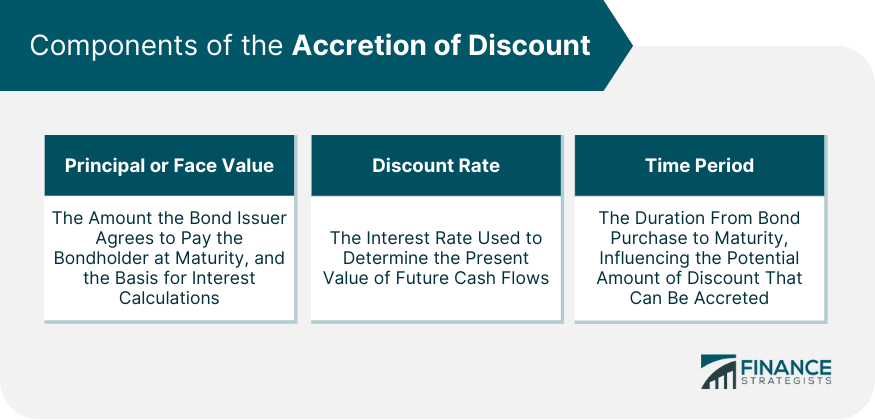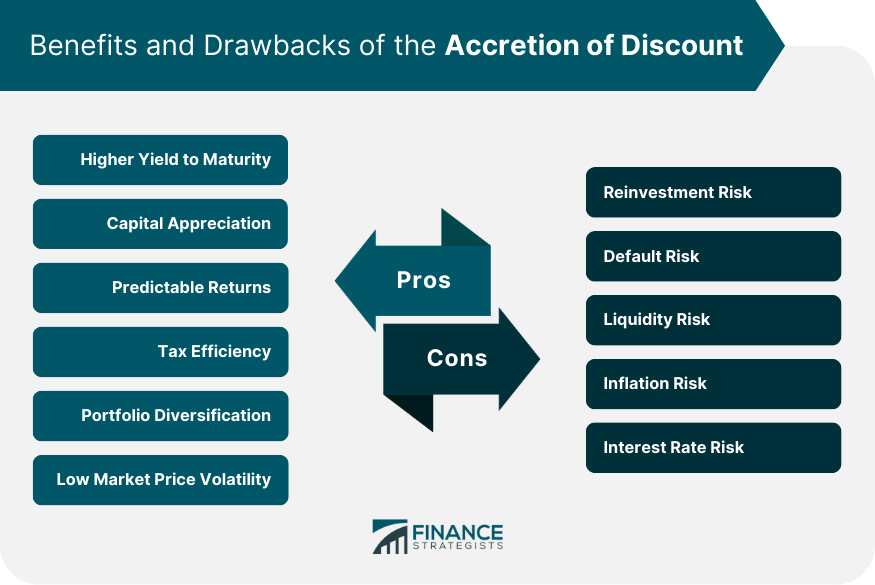What Is the Accretion of Discount?
The Accretion of discount refers to the increase in the value of a discounted instrument as time passes and the maturity date draws nearer. Discounted instruments are usually financial products like bonds that are purchased below face value.
As the bond approaches its maturity date, it gradually increases in value, eventually reaching its full face value. This increase is known as the accretion of discount.
The concept of accretion of discount can be likened to an investment growing in value over time. When a bond or another financial instrument is purchased at a discount, the investor essentially locks in the interest income upfront.
Over time, this interest is "accreted," or added, to the original purchase price until, at maturity, the bond is worth its full face value.
The Accretion of discount plays a pivotal role in investment analysis. By understanding the concept, investors can estimate the potential return on discounted bonds and other similar financial products.
Accretion of Discount Principles
Present Value and Future Value
At the heart of the accretion of discount are the principles of present and future value. The present value is the current worth of a future sum of money or stream of cash flows given a specified rate of return.
Conversely, future value is the value of an asset or cash at a specified date in the future based on an assumed rate of return.
When an investor buys a bond at a discount, they buy a financial instrument with a future value (face value) for less than that amount in the present. Over time, as the bond's value accretes, it moves from its present value (purchase price) toward its future value.
Interest Rates
Interest rates play a significant role in the accretion of discount. A higher interest rate results in a larger discount to the face value of the bond, which, in turn, increases the amount of discount that can be accreted over the life of the bond.
A key consideration for investors is that changes in prevailing interest rates can impact the rate of accretion. If interest rates rise, the value of the bond may not accrete as quickly as initially expected, which may result in a lower return on investment.
Time Value of Money
This concept posits that a dollar today is worth more than a dollar at a future date due to its potential earning capacity.
Accretion of discount is essentially the time value of money in reverse. Instead of investing a sum of money now and watching it grow over time, an investor buys a bond at a discount and watches its value increase (or accrete) as it approaches maturity.
Components of the Accretion of Discount
Principal or Face Value
The principal or face value is the amount of money the bond issuer agrees to pay the bondholder when the bond matures. It's the sum the bond is worth at maturity and the amount on which interest payments are calculated.
In the context of accretion of discount, the face value is the value that the discounted bond or other financial instrument is moving towards as it accretes.
Discount Rate
The discount rate is the interest rate used to bring future amounts of money to its present value. This rate is fundamental to determining the purchase price of the discounted bond.
In accretion, the discount rate helps in determining the rate at which the value of the bond increases over time. A higher discount rate leads to a lower initial purchase price and, consequently, a higher potential gain from the accretion of discount.
Time Period
The time period refers to the length of time from when the bond is purchased to when it matures. The longer the time to maturity, the greater the amount of discount that can be accreted, assuming a constant discount rate.

Accretion of Discount and Bonds
Zero-Coupon Bonds
Zero-coupon bonds are bonds that do not pay periodic interest. Instead, they're issued at a deep discount to face value and pay their full face value when they mature. The difference between the purchase price and the face value is the interest earned by the investor.
These bonds are an excellent example of accretion of discount. The investor purchases the bond at a deep discount and realizes a return as the bond accretes to its face value over time.
Deep-Discount Bonds
Deep-discount bonds are similar to zero-coupon bonds, but with one key difference: they do pay some interest, but the amount is less than the prevailing market rate. These bonds are sold at a discount to compensate the investor for the lower interest rate.
The accretion of discount process is more complex with deep-discount bonds than with zero-coupon bonds because the interest payments must be factored into the accretion calculation.
Accretion of Discount and Investment Analysis
Impact on Yield
Yield refers to the earnings generated and realized on an investment over a specific period. It includes interest or dividends received from holding a particular investment.
Because discounted bonds are purchased below face value, they often have higher yields than bonds purchased at face value. As the bond accretes, the yield realized by the investor increases.
Risk and Return Considerations
Buying a bond at a discount locks in a return for the investor, making discounted bonds less risky than bonds purchased at or above face value, assuming the bond issuer does not default.
However, the risk associated with changes in market interest rates remains. If interest rates rise, the value of the bond may not accrete as quickly as expected, potentially reducing the investor's return.
Comparing Accreted and Stated Interest Rates
The stated interest rate is the rate noted on the bond's indenture at issuance and is used to calculate the bond's interest payments.
On the other hand, the accreted interest rate, often referred to as the effective interest rate or yield to maturity (YTM), is the rate of return earned by an investor who buys the bond at a discount and holds it until maturity.
Benefits of the Accretion of Discount
Higher Yield to Maturity
When bonds are bought at a discount, the yield to maturity is higher than the bond's stated interest rate. This is because the YTM takes into account the accretion of the discount in addition to the bond's coupon payments.
This higher return can be especially attractive to investors in a low interest rate environment.
Capital Appreciation
The principal value of a discounted bond increases over time, moving from the discounted purchase price toward the bond's face value. This process of accretion can lead to capital appreciation, providing an additional return beyond the bond's interest payments.
Predictable Returns
Assuming no default by the bond issuer, the accretion of discount provides a predictable, fixed rate of return. The investor knows upfront the amount they will receive at maturity, which can aid in financial planning and budgeting.
Tax Efficiency
Some bonds, such as zero-coupon bonds, do not pay annual interest. Instead, their return comes entirely from the accretion of discount. In many jurisdictions, this means that taxes are not due until the bond is sold or matures, allowing the investment to grow tax-free in the meantime.
Portfolio Diversification
Bonds purchased at a discount offer an opportunity for portfolio diversification. They may behave differently from other fixed income securities and equity investments in response to market changes, thereby reducing portfolio risk.
Low Market Price Volatility
This is because a significant portion of the return from discounted bonds comes from the accretion of discount rather than from coupon payments, which makes them less sensitive to changes in market interest rates.
Drawbacks of the Accretion of Discount
Reinvestment Risk
Particularly relevant to zero-coupon bonds and deep-discount bonds, these instruments do not make regular coupon payments that investors can reinvest. Thus, if interest rates decrease, investors may not have the opportunity to reinvest their returns at a comparable interest rate.
Default Risk
While the accretion of discount is predictable, it is contingent on the bond issuer not defaulting on their obligations. If the issuer defaults, the investor may lose a portion or all of their investment.
Liquidity Risk
Some discounted bonds, especially those issued by smaller or less-known entities, may be less liquid than other bonds. This means that if the investor needs to sell the bond before maturity, they may not be able to do so quickly or may need to sell at a price that significantly reduces their return.
Inflation Risk
The fixed income stream of discounted bonds may not keep pace with inflation, particularly over the long term. This risk could reduce the real (inflation-adjusted) value of the returns and the principal repaid at maturity.
Interest Rate Risk
Although discounted bonds are generally less sensitive to interest rate changes, they are not completely immune. If interest rates rise significantly, the price of existing bonds falls, meaning investors needing to sell the bond before maturity could receive less than the purchase price.

Final Thoughts
The Accretion of discount is a fundamental principle in investment analysis, particularly in the context of bonds and other discounted financial instruments.
By understanding the principles of present value and future value, as well as the impact of interest rates and the time value of money, investors can estimate potential returns and gauge the intrinsic value of their investments.
Accretion of discount allows for a more comprehensive assessment of an investment's performance and aids in comparative analysis of different investment options.
Accretion of discount offers several benefits to investors, such as higher YTM, capital appreciation, predictable returns, tax efficiency, portfolio diversification, and low market price volatility. However, there are also drawbacks to consider, including reinvestment, default, liquidity, and interest rate risks.
It is imperative to consult a financial advisor for further guidance on accretion of discount to ensure you make informed decisions and maximize your investment potential.
They can help you navigate the complexities involved, provide personalized recommendations, and tailor a strategy that aligns with your financial objectives.
Accretion of Discount FAQs
Accretion of discount refers to the increase in value of a discounted financial instrument, such as a bond, as it approaches maturity.
Accretion of discount can lead to higher yields to maturity compared to the bond's stated interest rate, providing potential for increased investment returns.
Interest rates play a significant role in the accretion of discount, as higher rates can result in larger discounts and greater accretion potential. The time period until the bond matures also affects the amount of discount that can be accreted.
No, accretion of discount primarily applies to discounted bonds, specifically zero-coupon bonds and deep-discount bonds that are purchased below face value.
Investors should be aware of reinvestment risk, default risk, liquidity risk, inflation risk, and interest rate risk when considering the accretion of discount. These risks can impact the return and value of the investment.
True Tamplin is a published author, public speaker, CEO of UpDigital, and founder of Finance Strategists.
True is a Certified Educator in Personal Finance (CEPF®), author of The Handy Financial Ratios Guide, a member of the Society for Advancing Business Editing and Writing, contributes to his financial education site, Finance Strategists, and has spoken to various financial communities such as the CFA Institute, as well as university students like his Alma mater, Biola University, where he received a bachelor of science in business and data analytics.
To learn more about True, visit his personal website or view his author profiles on Amazon, Nasdaq and Forbes.











